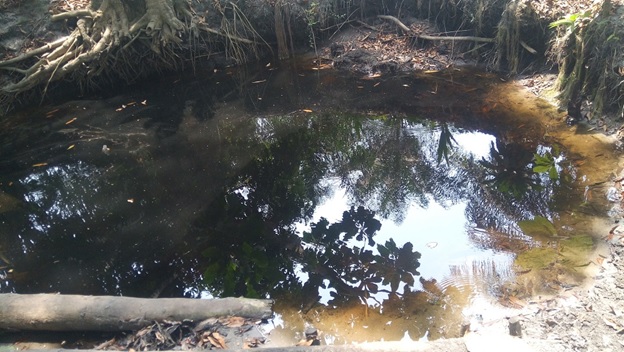By Ahmed Sahid Nasralla (De Monk)
Located in the Southern Province of Sierra Leone, with 32 miles long and 15 miles wide covering an area of approximately 230 square miles, Bonthe Sherbro Island is one of the areas with the greatest food insecurity and poorest access to WASH facilities in the small West African country.
Communities in Bonthe largely get their drinking water from rivers or brooks, which is a serious health risk.
“The greatest challenge in the Sherbro Island has been water and the water we are drinking has a lot of salt in it. The water resembles clay. There is no school with WASH facilities not to talk about good toilet,” said Mayor of the Bonthe Municipal Council, Layemin Joe Sandi.
Moreover, according to the 2015 Comprehensive Food Security and Vulnerability Assessment (CFSVA) conducted by the World Food Programme (WFP), 49.8% of households across Sierra Leone are affected by food insecurity, and 59.7% in rural areas. Since 2010, food insecurity in Bonthe region has doubled, making it one of the most food insecure districts in the country.
A 2013 Government of Sierra Leone health survey found that only 6.3% of children in rural areas receive an acceptable minimum food supply. According to the “Sierra Leone National Nutrition Survey” of 2017, chronic malnutrition in children, measured by “stunting”, is 31.4% in Bonthe and the district has the highest prevalence of childhood diseases. Malnutrition and diarrhoeal diseases are therefore among the main causes of infant mortality.
It is against this challenging backdrop that the NGO SEND Sierra Leone, with funding from German Federal Ministry for Economic Cooperation and Development (BMZ) and Deutsche Welthungerhilfe (WHH), recently launched the ‘Promotion of Nutrition Sensitive WASH Self-Sufficiency project’ in Bonthe Sherbro Island, specifically targeting 50 very remote communities in Sittia and Dema chiefdoms.
The project’s overall objective is to contribute in improving the nutritional and health status of up to 1,000 households in the Bonthe Sherbro Island through the construction of water supply and sanitation infrastructure in targeted communities; establishment of structures for sustainable community participation; (financial) contributions to the development and maintenance of the WASH sector/institutions; and enabling households’ and communities’ access to improved WASH facilities through a WASH self-supply system.
Sittia and Dema chiefdoms depend on unprotected hand dug wells for drinking water and lack latrines, relying more on open defecation along the beach areas. The communities also have low knowledge on hygiene, nutrition and best sanitation practices. Due to the sandy soil, large number of the communities can only be accessed by motor boat, which is very expensive and in most communities, income is generated through the sale of fish. Agricultural activities also remain poor and at an insignificant scale to be able to provide sufficient food and income for the people. Development activities hardly reach this part of the country due to its riverine ecology, sandy soil and lack of inadequate river transport facilities, thereby limiting business activities.
“The project seeks to help the people of Bonthe District overcome these serious development challenges to be self-reliant, to be able to do things for themselves as a people. Government won’t be able to do everything for every community; government just won’t,” said Mohamed Jalloh, SEND Sierra Leone Project Manager during the project inception meeting with stakeholders from the target communities at the Bonthe Municipal Council Hall early March 2019.
During the meeting the project details, including budget and time lines, were shared with the stakeholders, seeking their reactions and inputs. According to Jalloh, that was to ensure the they understand the project package and to have a stake in it from the start. The stakeholders comprise Paramount Chiefs from the target communities, Councilors, women and youth leaders, representatives from the Health, Agriculture and Water ministries, the District Council, security sector, donors and the implementing partners.
“We want to get the stakeholders from the target communities to be involved every step of the way; to let them know their responsibilities and we work together to achieve the objectives of the project,” continued Jalloh.
According to Jalloh, the project will facilitate the mobilization of communities to participate in the development of WASH facilities through the community WASH self-supply approach. This is a participatory sensitization process in which the communities become aware of their hygiene and sanitation challenges and jointly develop solutions using the Community Led Total Sanitation (CLTS) or the Participatory Hygiene and Sanitation Transformation (PHAST) approaches.
By the WASH self-supply approach, he continued, communities will be sensitized on gender, WASH, nutrition, village savings and loan scheme (VSLA), microfinance, business development and how communities can promote self-initiatives to mobilize resources on their own to develop low cost WASH project proposals to a Proposal Evaluation Committee set up by the project. When a community proposal is selected, the Water and Sanitation Promotion (WASAP) Company will be responsible for installations as experts on the self-supply approach to make sure communities develop water, toilets and other sanitary facilities to improve on their WASH status.
“We will recruit and train 100 community multipliers to serve as intermediaries in carrying out community mobilization and awareness raising activities on the project content and approaches in addition to three trained local technicians in each community who will continue to provide WASH services to communities after the project shall have ended,” disclosed Jalloh.
He added that about 50 representatives from the DHMT, DC, the media, Ministry of Water Resources (MoWR), the Ministry of Agriculture, Forestry and Food Security (MAFFS), and community chiefs will be directly involved in the project through evaluation, monitoring and steering activities; plus an indirect target group of 3,000 households (18,000 persons) to be reached through the rollout and replication of the project activities.
Meanwhile, Mayor Sandi said they are happy for the project and commended the NGO for the kind of transparency they have begun to show from the start.
Credit: Development and Economic Journalists Association (DEJA-SL).


